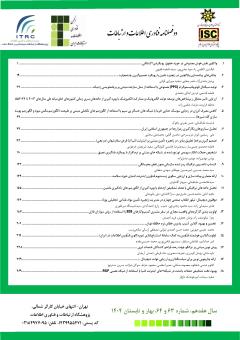ارائه معماری،پیاده سازی و ارزیابی سکوی زیستبوم فناوری اینترنت اشیای حوزه سلامت
محورهای موضوعی : فناوری اطلاعات و ارتباطاتسیدغلامحسن طباطبائی 1 * , سروناز آقاداودی 2
1 - مجتمع دانشگاهی برق و کامپیوتر، دانشگاه صنعتی مالک اشتر، تهران، ایران
2 - مجتمع دانشگاهی برق و کامپیوتر، دانشگاه صنعتی مالک اشتر، تهران، ایران
کلید واژه: اینترنت اشیا, شبکه نسل پنجم, برشبندی شبکه, رایانش ابری, شبکه نرمافزارمحور, مجازیسازی توابع شبکه.,
چکیده مقاله :
امروزه ارائه خدمات مراقبتهای بهداشتی از قرار ملاقات حضوری با پزشکان بهپیش بینی بیماری از طریق نظارت از راه دور تبدیلشده و مراقبتهای بهداشتی از رویکرد سنتی متمرکز بر بیمارستان، به رویکرد بیمار محور توزیعشده تغییر یافت است. بکارگیری اینترنت اشیا بهعنوان فناوری که توانایی فراهم کردن رویکرد بیمار محور توزیعشده را دارد امری حائز اهمیت است. ارائه معماری و به تبع آن سکویی که بتواند این نیاز را مرتفع کند برای سازمانهای بهداشتی و نهادهای مربوطه بسیار ارزشمند محسوب میشود بهاینعلت که هزینههای پیشگیری برای شهروندان و دولت بهصرفهتر از هزینههای درمان لحاظ میگردد. برای پاسخدهی به مسائل مطرحشده، معماری مفهومی بر اساس تلفیق فناوریهای اینترنت اشیا، 5G، رایانش مه/لبه، رایانش ابری، برش شبکه، شبکه نرمافزار محور و مجازیسازی توابع شبکه برای مانیتورینگ الکترونیک سلامت شهروندان ارائهشده است. از انواع حسگرهای پزشکی و محیطی برای رصد لحظهای و دورهای شهروندان و شرایط محیطی آنان استفادهشده است؛ بنابراین هدف اصلی این تحقیق ارائه یک معماری زیستبوم فناوری اینترنت اشیا حوزه سلامت در راستای ارتقاء کیفیت و سطح سلامت شهروندان و پاسخگویی به مسائل حوزه سلامت بهعنوان راهکاری مقرونبهصرفه است. زیستبوم مذکور مختص حوزه سلامت بوده و به دلیل ارائه برشهای شبکه سلامت در دیگر حوزهها نمیتوان آن را بکار گرفت. نتایج بهدستآمده از ارزیابی راهکار مبتنی بر معیارهای کارایی و مقیاسپذیری، نشاندهنده مطلوب بودن راهکار مذکور میباشد زیرا زمان اجرا تا 100 گره زیر یک ثانیه محاسبه گردیده است. معماری مذکور میتواند در مقیاس بزرگ پیادهسازی و بکار گرفته شود و درعینحال کارایی مناسب خود را حفظ نماید. در راهکار پیشنهادی خطر خسارات جانی نابهنگام در شهروندان کاهش پیدا میکند به دلیل اینکه با پایش لحظهای شهروندان بدون سابقه بیماری و شهروندان دارای سابقه بیماری تحت مراقبت در صورت وقوع موقعیت بحرانی با امدادرسانی بهموقع از درصد تلفات جانی کاسته خواهد شد و نتیجه استفاده از این راهکار به نفع سازمانها و نهادهای استفادهکننده خواهد بود.
Nowadays, healthcare delivery has shifted from in-person appointments with doctors to disease prediction through remote monitoring, and healthcare has shifted from a traditional hospital-centric approach to a distributed patient-centric approach. It is important to use the Internet of Things as a technology that can provide a distributed patient-centric approach. Providing an architecture and, consequently, a platform that can meet this need is very valuable for healthcare organizations and related institutions, because prevention costs are considered more economical for citizens and the government than treatment costs. To respond to the issues raised, a conceptual architecture based on the integration of IoT technologies, 5G, fog/edge computing, cloud computing, network slicing, software-defined networking, and network function virtualization has been presented for electronic monitoring of citizens' health. A variety of medical and environmental sensors have been used to monitor citizens and their environmental conditions in real time and over time; Therefore, the main goal of this research is to present an IoT technology ecosystem architecture in the health sector in order to improve the quality and level of health of citizens and respond to health issues as a cost-effective solution. The ecosystem is specific to the health sector and cannot be used in other sectors due to the provision of health network slices. The results obtained from evaluating the solution based on efficiency and scalability criteria indicate the desirability of the solution because the execution time for up to 100 nodes has been calculated to be less than 1 second. The architecture can be implemented and used on a large scale and at the same time maintain its appropriate efficiency. In the proposed solution, the risk of premature loss of life in citizens is reduced because by real-time monitoring of citizens without a history of illness and citizens with a history of illness under care in the event of a critical situation, the percentage of life losses will be reduced with timely assistance, and the result of using this solution will be in the interest of user organizations and institutions.
[1] A. Mukherjee, S. Ghosh, A. Behere, S. K. Ghosh, and R. Buyya, "Internet of health things (IoHT) for personalized health care using integrated edge-fog-cloud network," Journal of Ambient Intelligence and Humanized Computing, vol. 12, pp. 943-959, 2021.
[2] E. Kapassa et al., "An innovative ehealth system powered by 5G network slicing," in 2019 Sixth International Conference on Internet of Things: Systems, Management and Security (IOTSMS), 2019: IEEE, pp. 7-12.
[3] P. H. Vilela, J. J. Rodrigues, P. Solic, K. Saleem, and V. Furtado, "Performance evaluation of a Fog-assisted IoT solution for e-Health applications," Future Generation Computer Systems, vol. 97, pp. 379-386, 2019.
[4] A. H. Celdrán, M. G. Pérez, F. J. G. Clemente, F. Ippoliti, and G. M. Pérez, "Dynamic network slicing management of multimedia scenarios for future remote healthcare," Multimedia Tools and Applications, vol. 78, pp. 24707-24737, 2019.
[5] T. D. Mou and G. Srivastava, "Network Protocols for the Internet of Health Things," in Intelligent Internet of Things for Healthcare and Industry: Springer, 2022, pp. 21-66.
[6] S. Wijethilaka and M. Liyanage, "Survey on network slicing for Internet of Things realization in 5G networks," IEEE Communications Surveys & Tutorials, vol. 23, no. 2, pp. 957-994, 2021.
[7] R. Scott and D. Östberg, "A comparative study of open-source IoT middleware platforms," ed, 2018.

